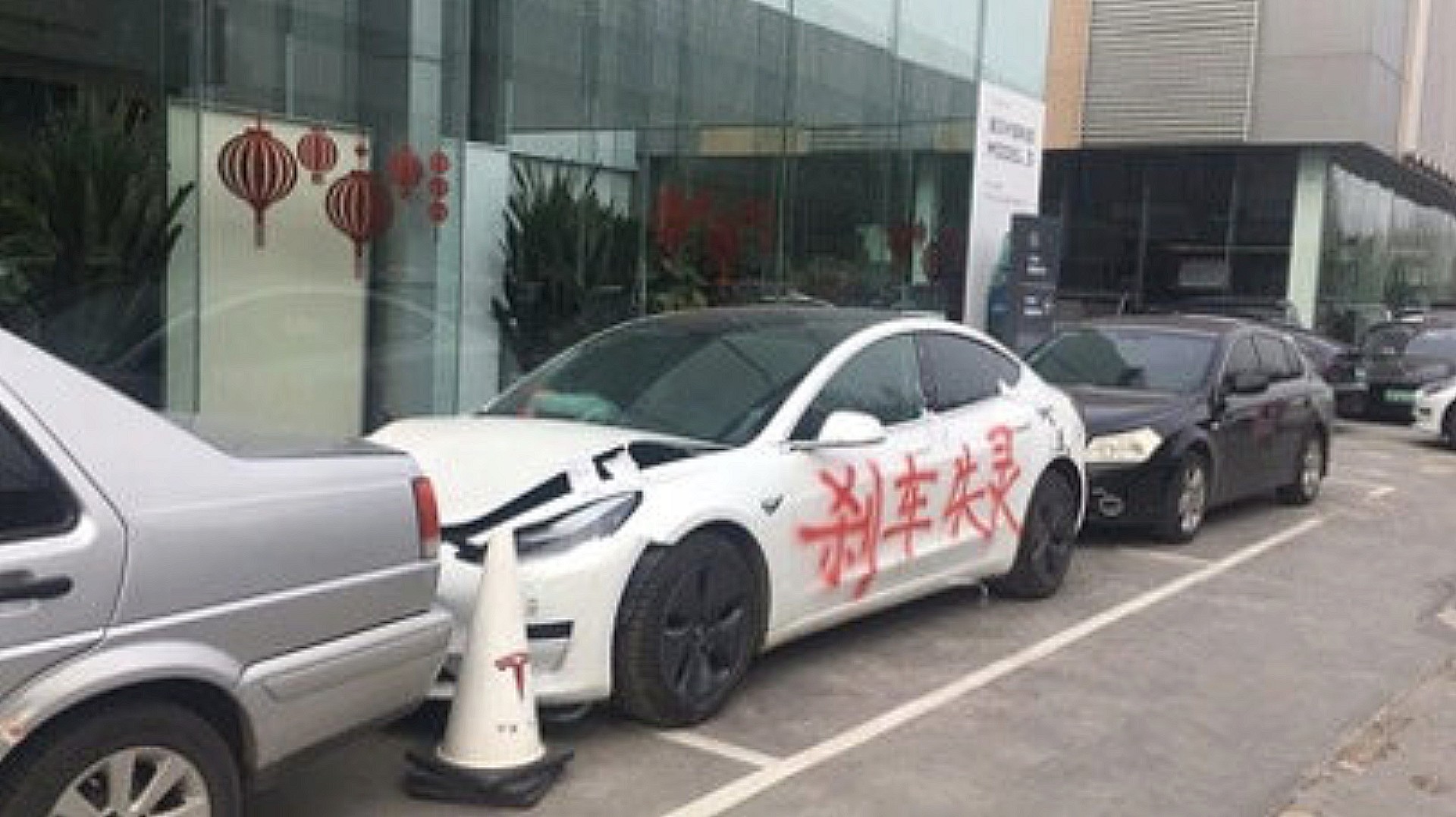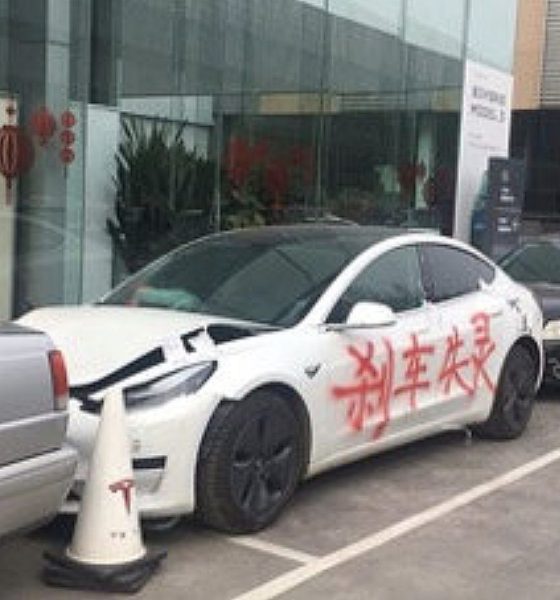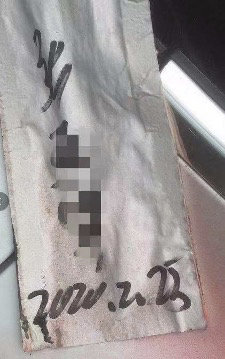

News
Tesla says ‘brake failure’ protestor vandalized Model 3, refused third-party testing
Tesla is navigating through a difficult bout with an owner in Shanghai, China, named Zhang Yazhou, who appeared at the Shanghai Auto Show last week in protest of what she claimed was a faulty Model 3 braking system. Tesla has now issued a more lengthy and detailed description of their encounters with Mrs. Zhang, revealing that she not only vandalized her own car with red spray paint, but she also denied any requests made by Tesla to have an independent, third-party company investigate whether the Model 3 had braking issues.
On April 19th, Zhang climbed on top of a Model 3 that was positioned at the Tesla booth at the Shanghai Auto Show. Wearing a shirt that said “Tesla Brake Failure,” Zhang yelled “Tesla brakes failed me” to a crowd of spectators who surrounded the all-electric sedan. As a result, Tesla has released several responses, including data from the accident that showed the driver, who was actually Zhang’s father, was driving at a speed that was above the posted speed limit and engaged the braking system successfully on more than 40 occasions in the half-hour leading up to the accident.
Now, Tesla is making more attempts to reveal the story to the public and is revealing its interactions with Zhang.
The Tesla Model Y is leading China’s electric SUV segment by a wide margin
On Tesla’s official Weibo page, the company stated that Zhang talked to Tesla on April 27th, and the automaker was willing to continue communicating and try to come to a solution. After a five-day stint with the Police following the protest, Zhang returned home and told Tesla reps, “I just came back. I need to adjust. I hope you can show an attitude that really solves the problem. When you have this attitude, we will communicate.”
Tesla revealed that Zhang was in the passenger’s seat during the accident and that traffic police came to the conclusion that the driver, Zhang’s father, was “fully responsible for the accident because he did not maintain a safe distance from the vehicle in front.” After the vehicle arrived at a local service shop for repairs on February 22, Tesla says Ms. Zhang put a seal on the vehicle three days after its arrival so nobody could enter the car. Tesla says that Zhang believed the vehicle’s data could be tampered with, and this was the reason for the seal being placed on the doors. Zhang had the still-wrecked vehicle towed to Tesla’s Zhengzhou Fotamen showroom on March 5th, where it would be sitting in the public for everyone to see.
Zhang’s door seals (Credit: Tesla | Weibo)
The following day, Zhang placed a banner that read “Brake Failure” on the car, and Tesla began offering Zhang the option of having third-party inspectors take a look at the car on their dime. Zhang refused, saying that she was not interested in having the car looked at by “non-accredited third-party testing agencies,” and warned that Tesla should “look for pressure from the media” if the car wasn’t returned.
Zhang placed a banner on the car that said “Brake Failure” as the Model 3 sat in front of its Zhengzhou Fotamen showroom. (Credit: Tesla | Weibo)
Zhang then came back to the showroom where her car was located and spraypainted the exterior of her wrecked Model 3 with red paint. The words once again said, “Brake Failure.”
“The Tesla staff are still actively communicating with Ms. Zhang, trying to find a solution, and negotiating with her husband, Mr. Li, hoping to minimize the impact and help her maximize the benefits within a reasonable range. Mr. Li made it clear that he still has a “team” from Beijing assisting him, and being helped by others in “cooperating” with others can only be obedient,” Tesla added. Zhang resealed her vehicle on March 21st.
Zhang spraypainted her wrecked Model 3 with red paint, with the words “Brake Failure” present on the driver’s side of the car. (Credit: Tesla | Weibo)
According to Tesla, Zhang then had the car towed to the Zhengzhou Dahe Auto Show, where two hired models stood beside the car. Zhang then made her appearance at the Shanghai Auto Show on April 19th. Tesla says that it is still working to iron out the situation and work with Zhang and her husband, who is identified as Mr. Li. Tesla sent a sealed version of the vehicle data that was available 30 minutes before the accident occurred to Zhang’s house.
“Since February, we have been doing our best to actively communicate with Ms. Zhang and her family. We sincerely hope that we can promote vehicle inspection as soon as possible and give a result to the friends who care about Tesla,” the company concluded.
You can read Tesla’s full response here.

News
Tesla FSD fleet is nearing 7 billion total miles, including 2.5 billion city miles
As can be seen on Tesla’s official FSD webpage, vehicles equipped with the system have now navigated over 6.99 billion miles.

Tesla’s Full Self-Driving (Supervised) fleet is closing in on almost 7 billion total miles driven, as per data posted by the company on its official FSD webpage.
These figures hint at the massive scale of data fueling Tesla’s rapid FSD improvements, which have been quite notable as of late.
FSD mileage milestones
As can be seen on Tesla’s official FSD webpage, vehicles equipped with the system have now navigated over 6.99 billion miles. Tesla owner and avid FSD tester Whole Mars Catalog also shared a screenshot indicating that from the nearly 7 billion miles traveled by the FSD fleet, more than 2.5 billion miles were driven inside cities.
City miles are particularly valuable for complex urban scenarios like unprotected turns, pedestrian interactions, and traffic lights. This is also the difference-maker for FSD, as only complex solutions, such as Waymo’s self-driving taxis, operate similarly on inner-city streets. And even then, incidents such as the San Francisco blackouts have proven challenging for sensor-rich vehicles like Waymos.
Tesla’s data edge
Tesla has a number of advantages in the autonomous vehicle sector, one of which is the size of its fleet and the number of vehicles training FSD on real-world roads. Tesla’s nearly 7 billion FSD miles then allow the company to roll out updates that make its vehicles behave like they are being driven by experienced drivers, even if they are operating on their own.
So notable are Tesla’s improvements to FSD that NVIDIA Director of Robotics Jim Fan, after experiencing FSD v14, noted that the system is the first AI that passes what he described as a “Physical Turing Test.”
“Despite knowing exactly how robot learning works, I still find it magical watching the steering wheel turn by itself. First it feels surreal, next it becomes routine. Then, like the smartphone, taking it away actively hurts. This is how humanity gets rewired and glued to god-like technologies,” Fan wrote in a post on X.
News
Tesla starts showing how FSD will change lives in Europe
Local officials tested the system on narrow country roads and were impressed by FSD’s smooth, human-like driving, with some calling the service a game-changer for everyday life in areas that are far from urban centers.

Tesla has launched Europe’s first public shuttle service using Full Self-Driving (Supervised) in the rural Eifelkreis Bitburg-Prüm region of Germany, demonstrating how the technology can restore independence and mobility for people who struggle with limited transport options.
Local officials tested the system on narrow country roads and were impressed by FSD’s smooth, human-like driving, with some calling the service a game-changer for everyday life in areas that are far from urban centers.
Officials see real impact on rural residents
Arzfeld Mayor Johannes Kuhl and District Administrator Andreas Kruppert personally tested the Tesla shuttle service. This allowed them to see just how well FSD navigated winding lanes and rural roads confidently. Kruppert said, “Autonomous driving sounds like science fiction to many, but we simply see here that it works totally well in rural regions too.” Kuhl, for his part, also noted that FSD “feels like a very experienced driver.”
The pilot complements the area’s “Citizen Bus” program, which provides on-demand rides for elderly residents who can no longer drive themselves. Tesla Europe shared a video of a demonstration of the service, highlighting how FSD gives people their freedom back, even in places where public transport is not as prevalent.
What the Ministry for Economic Affairs and Transport says
Rhineland-Palatinate’s Minister Daniela Schmitt supported the project, praising the collaboration that made this “first of its kind in Europe” possible. As per the ministry, the rural rollout for the service shows FSD’s potential beyond major cities, and it delivers tangible benefits like grocery runs, doctor visits, and social connections for isolated residents.
“Reliable and flexible mobility is especially vital in rural areas. With the launch of a shuttle service using self-driving vehicles (FSD supervised) by Tesla in the Eifelkreis Bitburg-Prüm, an innovative pilot project is now getting underway that complements local community bus services. It is the first project of its kind in Europe.
“The result is a real gain for rural mobility: greater accessibility, more flexibility and tangible benefits for everyday life. A strong signal for innovation, cooperation and future-oriented mobility beyond urban centers,” the ministry wrote in a LinkedIn post.
News
Tesla China quietly posts Robotaxi-related job listing
Tesla China is currently seeking a Low Voltage Electrical Engineer to work on circuit board design for the company’s autonomous vehicles.

Tesla has posted a new job listing in Shanghai explicitly tied to its Robotaxi program, fueling speculation that the company is preparing to launch its dedicated autonomous ride-hailing service in China.
As noted in the listing, Tesla China is currently seeking a Low Voltage Electrical Engineer to work on circuit board design for the company’s autonomous vehicles.
Robotaxi-specific role
The listing, which was shared on social media platform X by industry watcher @tslaming, suggested that Tesla China is looking to fill the role urgently. The job listing itself specifically mentions that the person hired for the role will be working on the Low Voltage Hardware team, which would design the circuit boards that would serve as the nervous system of the Robotaxi.
Key tasks for the role, as indicated in the job listing, include collaboration with PCB layout, firmware, mechanical, program management, and validation teams, among other responsibilities. The role is based in Shanghai.
China Robotaxi launch
China represents a massive potential market for robotaxis, with its dense urban centers and supportive policies in select cities. Tesla has limited permission to roll out FSD in the country, though despite this, its vehicles have been hailed as among the best in the market when it comes to autonomous features. So far, at least, it appears that China supports Tesla’s FSD and Robotaxi rollout.
This was hinted at in November, when Tesla brought the Cybercab to the 8th China International Import Expo (CIIE) in Shanghai, marking the first time that the autonomous two-seater was brought to the Asia-Pacific region. The vehicle, despite not having a release date in China, received a significant amount of interest among the event’s attendees.








